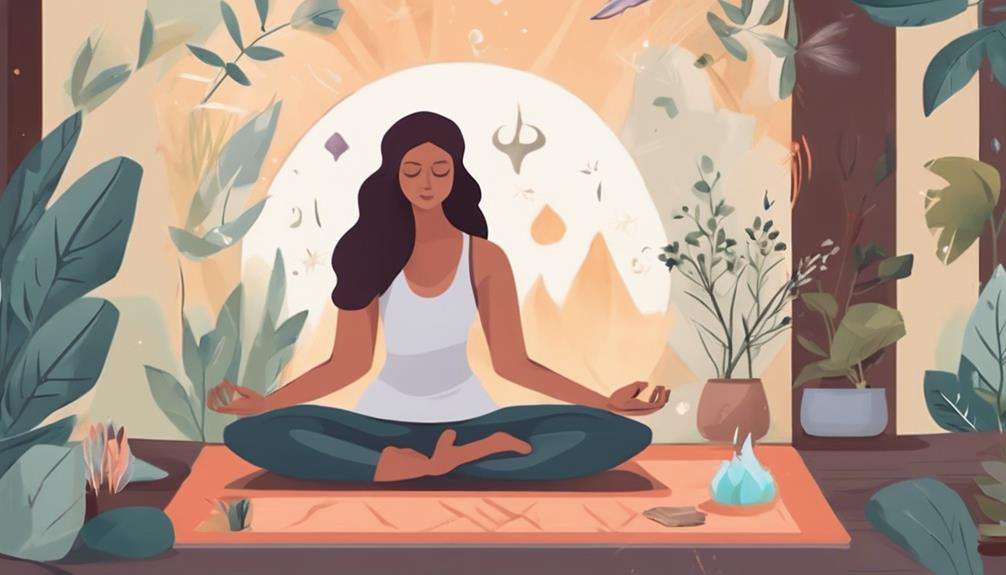If you seek a tranquil state of mind amidst the chaos of daily life, consider exploring various mindfulness practices that can guide you towards inner peace.
By incorporating simple yet powerful techniques into your routine, you can create a sanctuary of calm within yourself. These methods not only offer a path to tranquility but also pave the way for a more grounded and centered existence.
Each practice holds the potential to transform your relationship with the present moment and cultivate a profound sense of serenity within you.
Key Takeaways
- Practice mindfulness techniques for present moment awareness and inner peace.
- Use breathing exercises to calm the mind and cultivate mental clarity.
- Build tranquility through gratitude, social connections, and stress reduction.
- Embrace mindfulness to transform your relationship with the present and reduce stress levels.
Present Moment Awareness Practice
To cultivate tranquility through mindfulness practices, begin by engaging in the Present Moment Awareness Practice. This practice involves focusing your attention on the current moment without any judgment or distraction. By paying close attention to the sensations, thoughts, and emotions that arise in the present moment, you can enhance your mindfulness and reduce stress levels, ultimately promoting a sense of tranquility within yourself.
Mindfulness meditation is a powerful tool to develop present moment awareness. By anchoring yourself in the now, you can experience a deep connection with both your inner self and the world around you. This practice allows you to embrace the current reality without getting caught up in past regrets or future worries, leading to a profound sense of calm and inner peace.
Through consistent engagement with present moment awareness, you can train your mind to stay focused on the present, fostering a state of tranquility that permeates throughout your daily life. Embrace this practice wholeheartedly, and witness the transformative power of mindfulness in cultivating serenity within yourself.
Silent Mindfulness Exercise
When practicing silent mindfulness, focus on your breath and bodily sensations.
Observe your thoughts and emotions without judgment or reaction.
Cultivate tranquility through these exercises to find inner peace and mental clarity.
Breath Awareness Technique
Engage in the Breath Awareness Technique to center your focus on the present moment and cultivate inner tranquility. As you delve into this meditation practice, remember the power of deep breathing in calming the mind and body. Here are some essential points to guide you:
- Focus on the sensation of the breath entering and leaving the body to anchor your awareness.
- Notice the subtle movements of your body, like the rising and falling of the chest or the air passing through your nostrils.
- Use your breath as a point of concentration to cultivate tranquility and peace of mind.
- Allow thoughts to flow without judgment, gently guiding your focus back to your breath.
- Regular practice of breath awareness can enhance mindfulness, reduce stress, and promote inner peace.
Body Scan Meditation
As you explore the practice of Body Scan Meditation, you'll gradually shift your focus from breath awareness to a systematic attention on different parts of your body, fostering mindfulness and relaxation. This practice involves deep concentration on each body part, starting from your toes and moving up to your head.
By relaxing the body and bringing awareness to sensations in each area, you can release tension, increase body awareness, and calm your mind. Body scan meditation is a beneficial tool for reducing stress, enhancing sleep quality, and improving overall well-being. Whether you choose to do it lying down or sitting comfortably, this practice is accessible to individuals at all levels of meditation experience.
Give yourself the gift of mindfulness and relaxation through the practice of body scan meditation.
Observing Thoughts Practice
Embark on the journey of observing your thoughts with a sense of calm curiosity and detachment. As you practice observing thoughts, remember that this exercise is about simply being a silent witness to your inner mental processes. Here are some key points to consider during this observing thoughts practice:
- Witness your thoughts without judgment or attachment.
- Cultivate a non-reactive awareness of your mind's activities.
- Develop inner peace and detachment by not getting caught up in your thoughts.
- Recognize the transient nature of thoughts and emotions.
- Foster a sense of tranquility by observing your thoughts with equanimity.
Deep Breathing Techniques
When practicing deep breathing techniques, focus on inhaling slowly through your nose and exhaling completely to calm your nervous system.
Deep breathing allows you to direct your attention to the rhythm of your breath, helping you find a moment of peace in the midst of a busy day.
One effective method is the 4-7-8 technique: breathe in for 4 counts, hold for 7, and then exhale for 8 counts. This pattern can aid in relaxation and reduce stress.
Another useful technique is box breathing, where you inhale, hold, exhale, and pause for 4 counts each, promoting a sense of calmness and balance.
By focusing on your breath, you anchor yourself in the present moment, cultivating mindfulness and tranquility.
These conscious breathing practices offer a simple yet powerful way to alleviate stress and bring a sense of deep peace to your mind and body.
Breath Awareness Meditation

As you start exploring breath awareness meditation, remember to gently focus on the sensations of your breath entering and leaving your body.
These mindful breathing techniques can help anchor you in the present moment, fostering a sense of calm and clarity.
Embrace this practice as a way to deepen your connection to inner peace and tranquility.
Focus on Breath
To cultivate tranquility through mindfulness practices, one effective method is to focus on your breath using breath awareness meditation. This practice allows you to connect with the present moment and create a sense of calm within yourself.
Here are some tips to help you enhance your breath awareness meditation:
- Find a quiet and comfortable space to sit or lie down.
- Close your eyes and begin to notice the natural rhythm of your breath.
- Direct your attention to the sensation of air entering and leaving your nostrils or the rise and fall of your chest.
- Whenever your mind starts to wander, gently bring your focus back to your breath without judgment.
- Practice this regularly to improve mindfulness, reduce stress, and promote emotional well-being.
Mindful Breathing Techniques
To deepen your practice of cultivating tranquility through mindfulness, consider exploring various mindful breathing techniques, such as breath awareness meditation. This practice involves focusing on the natural rhythm of your breath, directing attention to the present moment. By honing in on the sensation of inhaling and exhaling, you promote relaxation, reduce stress levels, and boost your overall physical health.
Mindful breathing techniques serve as a powerful tool to calm the mind, allowing you to let go of distractions and anchor yourself in the now. Regular practice of breath awareness meditation can enhance your concentration, mental clarity, and emotional regulation. Embrace this practice to nurture your well-being and cultivate a sense of peace within.
Gratitude Cultivation Practice
Gratitude Cultivation Practice
Boost your mood and overall well-being by incorporating a daily gratitude cultivation practice into your routine. By focusing on the present moment and letting go of worries, you can enhance your life in numerous ways.
Here are some tips to help you get started:
- Start a gratitude journal: Take a few minutes each day to write down things you're grateful for. Reflect on both big and small blessings in your life.
- Express gratitude to others: Make it a habit to thank people who've positively impacted you. Sending a quick note or expressing appreciation can strengthen relationships.
- Practice mindfulness during daily tasks: Pay attention to the sensations and experiences during routine activities. Find gratitude in the simple moments of your day.
- Create a gratitude jar: Write down moments of gratitude on small pieces of paper and collect them in a jar. Witnessing the jar fill up can be a visual reminder of your blessings.
- Reflect on challenges: Even in difficult times, try to find lessons or silver linings. Practicing gratitude during adversity can foster resilience and growth.
Incorporate these practices into your daily life to cultivate a mindset of gratitude and invite more positivity into your world.
Unique Self-Appreciation Exercise

Embrace your uniqueness and foster self-appreciation by acknowledging the qualities and strengths that make you distinctly valuable. Take a moment in your day to engage in a guided meditation focused on Heightened Focus. Begin by finding a quiet space where you can sit comfortably and relax. Close your eyes and take deep breaths, allowing yourself to let go of any tension or stress.
As you breathe in and out, bring your awareness to your inner self. Reflect on your individual experiences, skills, and achievements that have shaped you into the person you're today. Celebrate your quirks, talents, and contributions that make you stand out. By recognizing and honoring your inner essence, talents, and abilities, you can foster a sense of self-love and acceptance.
This self-appreciation exercise can help you cultivate a deeper connection with yourself and boost your self-esteem and confidence. Embrace your authenticity and originality as you celebrate your uniqueness through this guided meditation, allowing yourself to feel a profound sense of self-worth and value.
Positive Social Connections Building
Building positive social connections is crucial for enhancing your tranquility and well-being. Surrounding yourself with supportive friends and a community that uplifts you can help you navigate challenging times with grace and strength.
Cultivating these relationships can lead to a more peaceful and fulfilling life.
Friendships for Tranquility
Surrounding yourself with positive and supportive individuals can significantly enhance your feelings of tranquility and peace. Positive social connections have the power to help you find the silver lining in every situation and offer strength when times get tough.
Here are some ways in which cultivating friendships can promote tranquility in your life:
- Encouragement: Friends who uplift and motivate you can bring a sense of peace.
- Understanding: Having people who empathize and listen can help you feel heard and supported.
- Joyful Moments: Sharing laughter and happiness with friends can create a peaceful environment.
- Reliability: Knowing you have dependable friends can reduce stress and increase tranquility.
- Mutual Growth: Building friendships based on trust and support can lead to harmony and inner peace.
Supportive Community Connections
Creating connections within a supportive community can be a vital step towards enhancing your overall well-being and sense of belonging. By fostering a sense of camaraderie and understanding, supportive community connections provide emotional support that reduces stress and feelings of isolation.
Engaging with a supportive community not only offers a sense of security but also promotes empathy and compassion among its members. These positive social interactions contribute significantly to mental health, resilience, and overall happiness.
Building strong social connections within a supportive community can lead to a profound sense of well-being and fulfillment. Remember, the relationships you cultivate within your community play a crucial role in nurturing your inner tranquility and creating a supportive environment for personal growth.
Mindful Breathing for Tranquility

To cultivate a sense of tranquility and relaxation, incorporating mindful breathing techniques into your daily routine can be incredibly beneficial. The practice of mindful breathing aligns with Buddha's teachings on mindfulness and can greatly help individuals struggling with anxiety and depression.
Here are five key benefits of integrating mindful breathing for tranquility into your life:
- Calming the Nervous System: Techniques like deep breathing, 4-7-8 breathing, and box breathing are effective in calming the nervous system and inducing relaxation.
- Present Moment Awareness: By focusing on the breath, you anchor yourself in the present moment, reducing stress and promoting tranquility.
- Reducing Mental Chatter: Conscious breathing redirects your attention to the breath, alleviating mental chatter and fostering mindfulness.
- Integrated Daily Practice: Mindful breathing can easily be integrated into your daily routines, helping you cultivate a sense of calm and inner peace.
- Emotional Regulation: Regular practice of mindful breathing enhances emotional regulation, reduces anxiety, and fosters a tranquil state of mind.
Meditation for Inner Peace
For those seeking a path to inner peace, meditation offers a powerful tool to calm the mind and reduce stress through focused awareness. The practice of meditation, rooted in ancient traditions like Buddhist meditation, invites you to pay attention to the present moment without judgment.
By engaging in regular meditation sessions, you can experience a sense of serenity and calmness that extends into your daily life. Through deep breathing exercises and a commitment to quieting the mind, meditation for inner peace provides a space for you to let go of worries and anxieties, allowing emotional well-being to flourish.
Cultivating tranquility through meditation not only enhances your inner peace but also fosters a deep sense of contentment within yourself. Embrace the practice of meditation as a pathway to finding harmony and stillness amidst the chaos of everyday life.
Mindfulness for Anxiety Reduction

Incorporate mindfulness practices to effectively reduce anxiety symptoms and promote a sense of present-moment calm and acceptance. When dealing with anxiety, focusing on the present moment can help alleviate distress and bring tranquility first.
Here are some ways mindfulness can aid in reducing anxiety:
- Direct your attention to the experience: By observing your thoughts and feelings without judgment, you can create distance from them and prevent being overwhelmed by anxiety.
- Practice mindful breathing techniques: Techniques like deep breathing and box breathing can help calm your nervous system, bringing a sense of relaxation and reducing anxiety.
- Anchor yourself in the present moment: Redirecting your attention to your breath can help you stay grounded and prevent anxious rumination from taking over.
- Embrace regular mindfulness practice: Research shows that consistent mindfulness practice can lead to significant reductions in anxiety levels over time.
- Cultivate acceptance and awareness: By accepting your current experience without resistance, you can foster a sense of peace and reduce anxiety's grip on you.
Frequently Asked Questions
How Do You Cultivate Tranquility?
To cultivate tranquility, you practice deep breathing for calmness and meditation techniques for clarity. By embracing these mindful practices, you create space for peace within yourself, fostering a serene and balanced state of mind.
How Can I Improve My Tranquility?
Take a moment each day to focus on your breath. Use mindfulness exercises and relaxation techniques to center yourself. Embrace the present, let go of worries, and find peace within. You deserve tranquility.
How Do You Cultivate Mindfulness?
To cultivate mindfulness, start with daily practices like meditation and deep breathing. Engage in mindfulness activities such as mindful walking or eating. Use reminders to stay present. Develop gratitude for positivity and tranquility.
How Do I Get to the State of Tranquility?
To reach tranquility, start by focusing on breath awareness. Utilize meditation techniques to quiet your mind and find peace within. Consistent practice and self-care will guide you towards a state of calm and serenity.
Conclusion
As you explore these mindfulness practices, remember that tranquility isn't a destination to reach, but a journey to embrace.
By incorporating these techniques into your daily routine, you can cultivate a sense of peace and serenity within yourself.
Keep in mind that true tranquility comes from within, and by staying present and mindful, you can navigate life's challenges with grace and ease.
Trust in the process and continue to nurture your inner peace.






